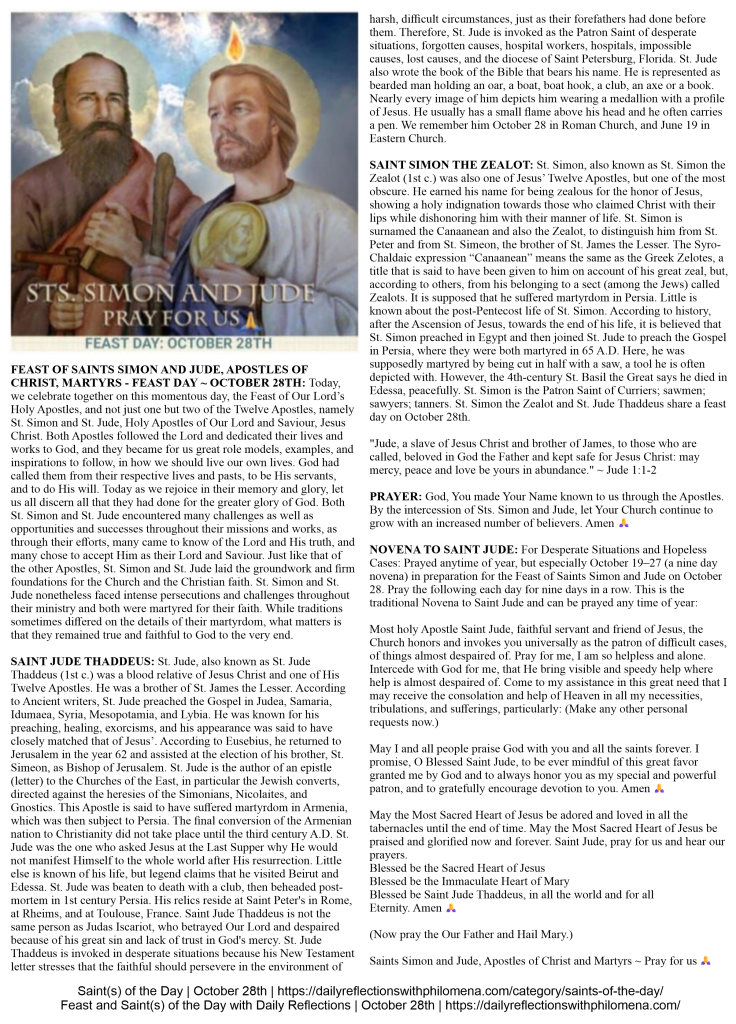
FEAST OF SAINTS SIMON AND JUDE, APOSTLES OF CHRIST, MARTYRS – FEAST DAY ~ OCTOBER 28TH: Today, we celebrate together on this momentous day, the Feast of Our Lord’s Holy Apostles, and not just one but two of the Twelve Apostles, namely St. Simon and St. Jude, Holy Apostles of Our Lord and Saviour, Jesus Christ. Both Apostles followed the Lord and dedicated their lives and works to God, and they became for us great role models, examples, and inspirations to follow, in how we should live our own lives. God had called them from their respective lives and pasts, to be His servants, and to do His will. Today as we rejoice in their memory and glory, let us all discern all that they had done for the greater glory of God. Both St. Simon and St. Jude encountered many challenges as well as opportunities and successes throughout their missions and works, as through their efforts, many came to know of the Lord and His truth, and many chose to accept Him as their Lord and Saviour. Just like that of the other Apostles, St. Simon and St. Jude laid the groundwork and firm foundations for the Church and the Christian faith. St. Simon and St. Jude nonetheless faced intense persecutions and challenges throughout their ministry and both were martyred for their faith. While traditions sometimes differed on the details of their martyrdom, what matters is that they remained true and faithful to God to the very end.
SAINT JUDE THADDEUS: St. Jude, also known as St. Jude Thaddeus (1st c.) was a blood relative of Jesus Christ and one of His Twelve Apostles. He was a brother of St. James the Lesser. According to Ancient writers, St. Jude preached the Gospel in Judea, Samaria, Idumaea, Syria, Mesopotamia, and Lybia. He was known for his preaching, healing, exorcisms, and his appearance was said to have closely matched that of Jesus’. According to Eusebius, he returned to Jerusalem in the year 62 and assisted at the election of his brother, St. Simeon, as Bishop of Jerusalem. St. Jude is the author of an epistle (letter) to the Churches of the East, in particular the Jewish converts, directed against the heresies of the Simonians, Nicolaites, and Gnostics. This Apostle is said to have suffered martyrdom in Armenia, which was then subject to Persia. The final conversion of the Armenian nation to Christianity did not take place until the third century A.D. St. Jude was the one who asked Jesus at the Last Supper why He would not manifest Himself to the whole world after His resurrection. Little else is known of his life, but legend claims that he visited Beirut and Edessa. St. Jude was beaten to death with a club, then beheaded post-mortem in 1st century Persia. His relics reside at Saint Peter’s in Rome, at Rheims, and at Toulouse, France. Saint Jude Thaddeus is not the same person as Judas Iscariot, who betrayed Our Lord and despaired because of his great sin and lack of trust in God’s mercy. St. Jude Thaddeus is invoked in desperate situations because his New Testament letter stresses that the faithful should persevere in the environment of harsh, difficult circumstances, just as their forefathers had done before them. Therefore, St. Jude is invoked as the Patron Saint of desperate situations, forgotten causes, hospital workers, hospitals, impossible causes, lost causes, and the diocese of Saint Petersburg, Florida. St. Jude also wrote the book of the Bible that bears his name. He is represented as bearded man holding an oar, a boat, boat hook, a club, an axe or a book. Nearly every image of him depicts him wearing a medallion with a profile of Jesus. He usually has a small flame above his head and he often carries a pen. We remember him October 28 in Roman Church, and June 19 in Eastern Church.
SAINT SIMON THE ZEALOT: St. Simon, also known as St. Simon the Zealot (1st c.) was also one of Jesus’ Twelve Apostles, but one of the most obscure. He earned his name for being zealous for the honor of Jesus, showing a holy indignation towards those who claimed Christ with their lips while dishonoring him with their manner of life. St. Simon is surnamed the Canaanean and also the Zealot, to distinguish him from St. Peter and from St. Simeon, the brother of St. James the Lesser. The Syro-Chaldaic expression “Canaanean” means the same as the Greek Zelotes, a title that is said to have been given to him on account of his great zeal, but, according to others, from his belonging to a sect (among the Jews) called Zealots. It is supposed that he suffered martyrdom in Persia. Little is known about the post-Pentecost life of St. Simon. According to history, after the Ascension of Jesus, towards the end of his life, it is believed that St. Simon preached in Egypt and then joined St. Jude to preach the Gospel in Persia, where they were both martyred in 65 A.D. Here, he was supposedly martyred by being cut in half with a saw, a tool he is often depicted with. However, the 4th-century St. Basil the Great says he died in Edessa, peacefully. St. Simon is the Patron Saint of Curriers; sawmen; sawyers; tanners. St. Simon the Zealot and St. Jude Thaddeus share a feast day on October 28th.
“Jude, a slave of Jesus Christ and brother of James, to those who are called, beloved in God the Father and kept safe for Jesus Christ: may mercy, peace and love be yours in abundance.” ~ Jude 1:1-2
PRAYER: God, You made Your Name known to us through the Apostles. By the intercession of Sts. Simon and Jude, let Your Church continue to grow with an increased number of believers. Amen 🙏